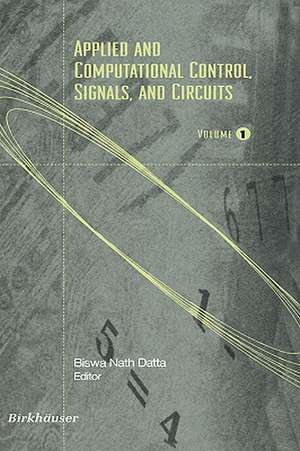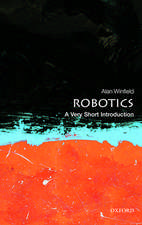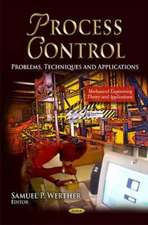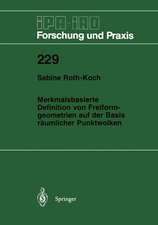Applied and Computational Control, Signals, and Circuits: Recent Developments: The Springer International Series in Engineering and Computer Science, cartea 629
Editat de Biswa Nath Dattaen Limba Engleză Hardback – 30 sep 2001
This collection will be an excellent reference work for research scientists, practicing engineers, and graduate level students of control and systems, circuit design, power systems and signal processing.
| Toate formatele și edițiile | Preț | Express |
|---|---|---|
| Paperback (1) | 640.71 lei 43-57 zile | |
| Springer Us – 9 noi 2012 | 640.71 lei 43-57 zile | |
| Hardback (1) | 647.59 lei 43-57 zile | |
| Springer Us – 30 sep 2001 | 647.59 lei 43-57 zile |
Din seria The Springer International Series in Engineering and Computer Science
- 24%
 Preț: 1041.97 lei
Preț: 1041.97 lei - 20%
 Preț: 643.50 lei
Preț: 643.50 lei - 18%
 Preț: 1225.62 lei
Preț: 1225.62 lei - 18%
 Preț: 965.02 lei
Preț: 965.02 lei - 20%
 Preț: 646.12 lei
Preț: 646.12 lei - 18%
 Preț: 948.79 lei
Preț: 948.79 lei - 20%
 Preț: 646.62 lei
Preț: 646.62 lei - 15%
 Preț: 637.46 lei
Preț: 637.46 lei - 20%
 Preț: 643.83 lei
Preț: 643.83 lei - 18%
 Preț: 949.23 lei
Preț: 949.23 lei - 20%
 Preț: 644.48 lei
Preț: 644.48 lei - 20%
 Preț: 994.92 lei
Preț: 994.92 lei - 20%
 Preț: 645.97 lei
Preț: 645.97 lei - 18%
 Preț: 946.87 lei
Preț: 946.87 lei - 20%
 Preț: 995.57 lei
Preț: 995.57 lei - 18%
 Preț: 956.99 lei
Preț: 956.99 lei - 20%
 Preț: 644.98 lei
Preț: 644.98 lei - 15%
 Preț: 649.54 lei
Preț: 649.54 lei - 18%
 Preț: 950.21 lei
Preț: 950.21 lei - 18%
 Preț: 1221.38 lei
Preț: 1221.38 lei - 18%
 Preț: 957.62 lei
Preț: 957.62 lei - 15%
 Preț: 643.99 lei
Preț: 643.99 lei - 18%
 Preț: 948.47 lei
Preț: 948.47 lei - 18%
 Preț: 947.35 lei
Preț: 947.35 lei - 20%
 Preț: 1284.65 lei
Preț: 1284.65 lei - 20%
 Preț: 1628.31 lei
Preț: 1628.31 lei - 20%
 Preț: 1285.78 lei
Preț: 1285.78 lei
Preț: 647.59 lei
Preț vechi: 761.87 lei
-15% Nou
Puncte Express: 971
Preț estimativ în valută:
123.91€ • 129.73$ • 102.53£
123.91€ • 129.73$ • 102.53£
Carte tipărită la comandă
Livrare economică 07-21 aprilie
Preluare comenzi: 021 569.72.76
Specificații
ISBN-13: 9780792374022
ISBN-10: 0792374029
Pagini: 285
Ilustrații: XVI, 285 p.
Dimensiuni: 155 x 235 x 21 mm
Greutate: 0.62 kg
Ediția:2001
Editura: Springer Us
Colecția Springer
Seria The Springer International Series in Engineering and Computer Science
Locul publicării:New York, NY, United States
ISBN-10: 0792374029
Pagini: 285
Ilustrații: XVI, 285 p.
Dimensiuni: 155 x 235 x 21 mm
Greutate: 0.62 kg
Ediția:2001
Editura: Springer Us
Colecția Springer
Seria The Springer International Series in Engineering and Computer Science
Locul publicării:New York, NY, United States
Public țintă
ResearchCuprins
1 Constant disturbance rejection and zero steady state tracking error for nonlinear systems design.- 1.1 Introduction.- 1.2 Problem Description.- 1.3 Sufficient Conditions for Constant Disturbance Rejection.- 1.4 Guaranteeing Stability with Integrator Augmentation.- 1.5 An Integrator Gain Bound.- 1.6 Alternative Locations for Including an Integrator.- 1.7 MIMO Systems.- 1.8 Controller Design for a Nonlinear Helicopter Model.- 1.9 Conclusion.- References.- 1.A Proof of Theorem 1.10.- 1.B Proof of Non-singularity.- 1.C Proof of the Existence of a Stabilising Diagonal Matrix K.- 2 Control Problems in Telecommunications: The Heavy Traffic Approach.- 2.1 Introduction.- 2.2 The Multiplexer Problem: Formulation.- 2.3 Controlled Admission in a Multiservice System: Formulation.- 2.4 A Scheduling and Polling Problem.- 2.5 Reflected Stochastic Differential Equations.- 2.6 Weak Convergence.- 2.7 The Multiplexer: Convergence and Optimality.- 2.8 Data for the Multiplexer Problem.- 2.9 Controlled Admission in ISDN: Proofs.- 2.10 The Polling Problem: Proofs.- References.- 3 Multi-Time PDEs for Dynamical System Analysis.- 3.1 Introduction.- 3.2 Multitime analysis of autonomous systems.- 3.3 LTV system macromodelling using the linearized MPDE.- 3.4 Future directions.- References.- 3.A Proof of Theorem 3.2 (MPDE Necessity Condition).- 3.B Proof of Theorem 3.3 (Uniqueness of Envelope).- 4 Formal Verification of Circuit Designs.- 4.1 Introduction.- 4.2 Models.- 4.3 Algorithms.- 4.4 Conclusion.- References.- 5 Large Scale Power System Computations: Applications of Iterative Techniques.- 5.1 Introduction.- 5.2 Mathematical Modeling.- 5.3 Basics of GMRES and GMRES(m) Methods.- 5.4 Applications to the Power Flow.- 5.5 Applications to Dynamic Simulation.- 5.6 Conclusions.- References.- 6 A Direction Set Based Algorithm for Adaptive Least Squares Problems in Signal Processing.- 6.1 Introduction.- 6.2 Structures and Properties of ALS Problems.- 6.3 The DS Based Algorithm for ALS Problems.- 6.4 Choices of Direction Sets.- 6.5 Implementation and Applications.- 6.6 The DS Based Algorithm for Spectral Estimation.- References.- 7 Model Reduction Software in the SLICOT Library.- 7.1 Introduction.- 7.2 Development of model reduction subroutines.- 7.3 Integration in user-friendly environments.- 7.4 Testing and performance comparisons on benchmark problems.- 7.5 Testing on industrial benchmark problems.- 7.6 Comparison of available model reduction tools.- 7.7 Summary of results and perspectives.- 7.A Sample user interface in Fortran.- 7.B Matlabmex-function interface.- 7.C Sample Matlabm-function interface.- 7.D Sample Scilab sci-function interface.- 7.E State space models for benchmark problems.- References.

















